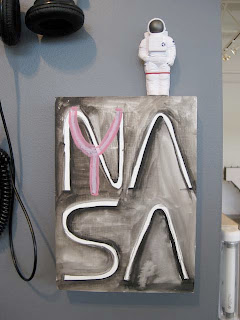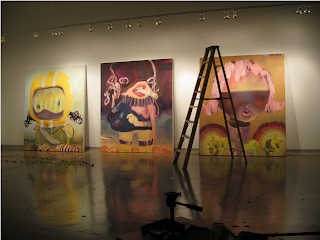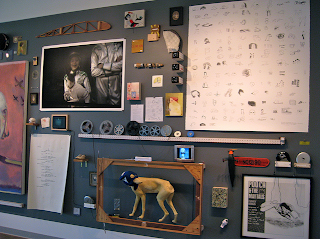April 1-14, 2011
Twist & Go
M.F.A. Painting candidate Jonathan Yoerger is keeping the discussion of the perplexing nature of Postmodernism alive, and I like it. Amongst all of the big –ism questions, discussions and aesthetics Postmodernism really does get caught up in its own cyclonic wind-up, and the tension, wonderment and suspense of whether it will move beyond this period is becoming much more engaging and optimistic than it was a decade ago and especially took precedence during the market collapse. As the art world emerges from the last pummeling Yoerger’s “Twist & Go” aesthetic is an optimistic tale of discovery, invention and the pleasantries of nostalgia.
Yoerger's work engages an assortment of eras, subcultures, markets and avant-gardes connected to one another by a method of strategic overlapping of familiar visual references. At the same time, he is entirely plugged into developing his own voice or in many ways his very own brand.

Front and center, through the glass storefront-like façade of the comfortably concise square gallery, is Yoerger’s blazing acronym of “YASA.” It stands for his very own “NASA-type” mission to pioneer in a not-so-descript space between art, science and commodity culture. Three larger than life painted female figures, his Space Chicks named after Columbus’ ships, the Nina, Pinta and Santa Maria, immediately bring the conversation to painting. Lining the wall adjacent to the lit “YASA” sculpture and looking like a trio of other worldly explorers who have just landed in the show, these super heroines seem to be surveying the environment, artifacts, remnants and sounds left behind by an eclectic group of inhabitants. It is unclear whether they’ve crash-landed in the shiny silver space capsule that floats in the gallery or if they too are listening in, carefully, to the sound of the Atlanta-based rap group emanating from the tiny vessel. My guesses is these three sultry Space Chics might have actually had something to do with the capsules’ change of course and ultimate system failing and are surprised at what they’ve discovered.

Jonathan Yoerger, Nina, Pinta and Santa Maria, 2011, oil on canvas, 90”x78” each. Photography by Whitney Dail.
An avid collector of a range of objects from taxidermy forms and wrestling masks to Vespas, bicycle parts, model airplanes and helmets, Yoerger’s exhibition integrates these artifacts, that tend to function in very separate worlds and imbues them with a unique second life. In giving these artifacts a new or renewed life Yoerger’s works operate in a manner similar to French philosopher Gaston Bachelard's poetics of space, in which he insists on the transfer of the poet's affectivity to the surrounding space and objects; a process, which endows all matter with a poetic essence and expands the intimate space into a poetic space: "To give an object its own poetic space is to give it more space than it has objectively [...], it is to follow the expansion of its intimate space." (see notes 1,2)

Jonathan Yoerger, Artifact Wall, Photography by Whitney Dail
These artifacts reveal what Yoerger explains as “histories that never happened,” rather than specific narratives, whereby adding to the mystery of their altered functions. His method for displaying these items involves reworking versions of them installed on his studio wall. Always changing and evolving within each new space. Yoerger displays found objects like film reels and a broken model propeller plane to hang comfortably with very large and very tiny oil paintings, small screens that kinetically vibrate with small animated GIF image sequences, sound bites and a slew of re-appropriated tinker toys, taxidermy critters and scooter helmets. They are hung together on a wall where a section is painted gray to denote the standard dimensions of his large acrylic on canvas paintings on the opposite side of the gallery. They reside in a world created by the artist and at the same time reflect aspects of their actual history providing the viewer, Yoerger notes, “with a case study of their own,” leaving an intermingling of visual imagery and objects teetering on the brink of “the end, a new beginning, a discovery or a hidden past.”
A work that best describes the theme of “Twist & Go” is a vintage police Vespa stockpiled complete with tool belt, video camera, a comic, radio, cup holder and parasol. It has all the things anyone could need and a little bit more and although it remains inoperable its accoutrements embody the distinct sensation of something at the ready and on the brink of release or escape. “Twist & Go” leaves us with an interesting awareness of nostalgia and wonderment that looks to the past via Yoerger’s pairing of uncanny and ad hoc imagery and propels scores of pathways setting viewers’ imaginations trailing off into a connected future somewhere on down the road. “Twist & Go” is a successful kick-start to a promising future in the arts.
1. Excerpt from the press release for “The Poetics of Space” at Galerie Marian Goodman, Paris (June 19 – July 24, 2008) curated by Anja Isabel Schneider.
2. Gaston Bachelard, La Poétique de l'espace, Paris, éd. Quadridge/PUF, 1994, p. 183.